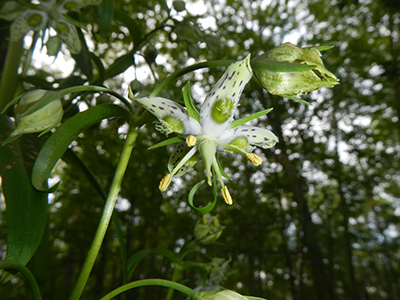American Columbo

Photo credit: © Colin Chapman CC BY-NC 4.0
Species information
The following is a report on progress made towards the protection and recovery of American Columbo (Frasera caroliniensis) in Ontario, from 2007 to 2018, based on species-specific policy. This report meets the legislative requirement for a review of progress under the Endangered Species Act, 2007 (ESA or “the Act”). American Columbo is listed as endangered on the Species at Risk in Ontario (SARO) List under the ESA.
American Columbo has been classified as a species at risk in Ontario since 2004. It was originally classified as a special concern species (in 2004) and was up-listed to endangered (in 2008). It retained its ‘endangered’ status under the ESA, when it came into force in June 2008.
As an endangered species, American Columbo has been protected from being killed, harmed, harassed, captured or taken, under the ESA, since 2008.
In addition, its habitat has been protected from being damaged or destroyed since June 30, 2013, based on the general definition of habitat in the ESA.
The species-specific policy for American Columbo, known as the Government Response Statement (GRS), was published in 2014, and includes the government’s recovery goal for the species, and the actions and priorities it leads or supports to help achieve that goal. The GRS considers science advice provided in the recovery strategy, when developing recovery actions for the species. As legislated in the Act, the purpose of this Review is to report on progress made towards implementing the protection and recovery actions in the GRS. The Review can also help identify opportunities to adjust and adapt the implementation of protection and recovery actions to achieve the recovery goal for the species.
Further information about American Columbo, including the threats it faces and actions being taken to help protect and recover this species, is available on the Government of Ontario webpage for American Columbo. A summary of progress made towards the protection and recovery of American Columbo, and an annual update on the species at risk program, are available on the Review of Progress towards the Protection and Recovery of Ontario’s Species at Risk webpage.
Snapshot
Progress towards the protection and recovery of American Columbo
- The recovery goal in the Government Response Statement (GRS) for American Columbo in Ontario is to
maintain the current population levels at existing locations in Ontario, and enable natural increases.
- Progress has been made towards implementing all government-led actions listed in the GRS. Progress has also been made towards achieving all government-supported recovery objectives, and implementing the majority of associated actions. Examples of progress include:
- Improving the suitability of habitat for American Columbo by improving the ground cover, understory, and canopy conditions, and providing increased light penetration to the forest floor
- Managing trail systems to restrict access to areas with species at risk, including American Columbo, and restoring trail heads by installing barriers and plantings to discourage unauthorized use
- Monitoring sites with American Columbo and noting the presence of flowers and the general health of each plant
- Providing outreach materials and engaging with private landowners who supported surveys to be conducted for American Columbo on their properties
- In alignment with the GRS, more work is required to
develop and implement a standardized monitoring protocol for all existing populations and to research the life history characteristics of American Columbo to inform the species’ recovery.
Occurrence and distribution
- Twenty populations
footnote 1 of American Columbo have been documented in southern Ontario, of which ten are extant, eight are considered historicalfootnote 2 , and two are considered extirpated. - Since 2008, the status of one population changed from extant to historical, and another population changed from historical to extirpated based on (i) the dates that these populations were last observed, and (ii) negative results during surveys at previously-documented locations. Nine extant populations have been re-confirmed since 2008.
Government-supported stewardship projects
- Through the Species at Risk Stewardship Program, the Government of Ontario has enabled its stewardship partners to conduct 14 projects ($596,098) that have supported the protection and recovery of American Columbo. One project focused exclusively on American Columbo, while the other 13 projects focused on multiple species at risk, including American Columbo.
- The government’s support helped its stewardship partners to involve 997 individuals who volunteered 10,859 hours of their time towards protection and recovery activities for species at risk, including American Columbo. The estimated value of these voluntary contributions, as well as additional funding and in-kind support, is $1,410,598.
- Stewardship partners reported that through their actions 241 hectares of habitat were enhanced for American Columbo and other species at risk that inhabit the same ecosystem.
- Stewardship partners reported providing outreach on multiple species at risk, including American Columbo, to 600,930 individuals.
Supporting human activities while ensuring appropriate support for species recovery
- The Government of Ontario has issued one ‘protection and recovery’ permit for this species under clause 17(2)(b) of the ESA.
- Twenty-four activities have been registered for the species, under ‘Drainage works’ (section 23.9), ‘Pits and quarries’ (section 23.14), and ‘Threats to health and safety, not imminent’ (section 23.18) sections of Ontario Regulation 242/08 , under the ESA.
Reporting on progress towards the protection and recovery of American Columbo
Recovery Goal
The government’s goal for the recovery of American Columbo is to maintain the current population levels at existing locations in Ontario, and enable natural increases.The implementation of government-led and government-supported actions demonstrates progress towards reaching the desired objectives and the recovery goal set out in the GRS.
Progress towards implementing government-led actions
Progress has been made towards implementing all GRS government-led actions. Common actions for the government to lead as it works toward achieving a species’ recovery goal include:
- Educate other agencies and authorities involved in planning and environmental assessment processes on the protection requirement under the ESA.
- Encourage the submission of American Columbo data to the government’s central repository at the Natural Heritage Information Centre (NHIC).
- Undertake communications and outreach to increase public awareness of species at risk in Ontario.
- Protect the American Columbo and its habitat through the ESA.
- Support conservation, agency, municipal and industry partners, and Indigenous communities and organizations to undertake activities to protect and recover the American Columbo. Support will be provided where appropriate through funding, agreements, permits with appropriate conditions, and/or advisory services.
- Encourage collaboration, and establish and communicate annual priority actions for government support in order to reduce duplication of efforts.
Additionally, the government has directly undertaken the following species-specific action:
- Continue to implement the Ontario Invasive Species Strategic Plan to address invasive species (for example, Dog-strangling Vine (Cynanchum rossicum)) that threaten American Columbo.
Key progress made towards implementing these actions is described in the following sections.
Ontario’s Invasive Species Act
The GRS for American Columbo indicates that invasive species (e.g., Dog-strangling Vine) pose a threat to the survival and recovery of the species in Ontario. The Ontario Invasive Species Strategic Plan, 2012 and the Invasive Species Act, 2015 provide the policy and legislative framework to support the prevention, detection and control of invasive species in Ontario. This framework may support the implementation of actions to reduce threats from invasive species.
Occurrence and distribution
Twenty populations of American Columbo have been documented in Ontario. Ten are considered to be extant (i.e., observed within the past 20 years), eight are considered historical and two are considered extirpated. The extant populations are located in the areas of Hamilton, Halton, Brant, and Niagara.
Since 2008, the government’s central repository at the Natural Heritage Information Centre (NHIC) has received 1,194 records of the species, based on observations between 1901 and 2018, from a variety of sources. Records submitted have helped to refine where the species is known and has been known to occur, and have provided additional information on the species’ habitat and threats.
Nine populations of American Columbo have been re-confirmed through observations, while two populations changed in status, since 2008. One population changed from extant to historical, and another population changed from historical to extirpated, based on (i) the dates these populations were last observed, and (ii) negative results during surveys at previously-documented locations. Of the extant populations, Sassafras Woods is known to support the largest number of individuals in Halton and possibly the province.
It is possible that there are observations of American Columbo that have not been submitted to the government. Encouraging the submission of observations of this species is included in the GRS as a government-led action. The submission of species observations increases our knowledge of where they occur, and can play an important role in assessing the viability
Everyone is encouraged, or may be required by an authorization or approval, to submit observations of American Columbo, and any other species at risk, to the NHIC for incorporation into the provincial record of observations. Observations may now be submitted to NHIC via the Rare Species of Ontario project in iNaturalist.
-
1,194observations of this species were submitted to the NHIC since 2008
Government-supported stewardship projects
An important government-led action in the GRS for American Columbo is to support partners to undertake activities to protect and recover the species. Through the Species at Risk Stewardship Program, the government has supported 14 projects ($596,098) designed to contribute to the protection and recovery of American Columbo
Stewardship partners reported that provincial funding helped them to secure in-kind support by involving 997 individuals who volunteered 10,859 hours of their time towards protection and recovery activities for multiple species at risk, including American Columbo, which has an estimated value of $321,976. Partners also reported that through their efforts and those of their volunteers to implement GRS actions, they were successful in enhancing 241 hectares of habitat that will benefit multiple species at risk, including American Columbo. In addition, stewardship partners reported providing ecosystem-based outreach on multiple species, including American Columbo, to over 600,930 individuals.
The remainder of this section highlights one project supported through the Species at Risk Stewardship Program.
Tallgrass Ontario improved habitat for American Columbo at the Blue Lake Savanna in Brant County. The project focused habitat restoration efforts on prescribed burning in March 2018, and the removal of invasive species such as such as Common Buckthorn (Rhamnus cathartica), which are removed by cutting tree trunks or coating stumps with herbicide with the intent to create improved growing conditions for American Columbo.
As part of the project, Tallgrass Ontario surveyed American Columbo in May of 2016 and 2018 to count the number of plants before and after habitat restoration work was completed. The 2018 survey resulted in the second highest number of American Columbo plants ever counted at this location and the highest number of plants observed since 2008 for this species. Approximately half of the total number of plants were categorized as small, which was higher than the number of small plants recorded in 2016. Tallgrass Ontario suggests this could be a result of seed germination and recruitment of new individuals post-burn from the last flowering year that American Columbo had been recorded, which was in 2014. Additionally, a new site at Blue Lake Savanna was discovered with American Columbo plants described as small or medium, indicating that these plants may have started growing after a prescribed burn by Tallgrass Ontario in 2012.
Overall, Tallgrass Ontario reported that the project resulted in a reduced canopy and improved growing conditions for American Columbo, which was accomplished by cutting invasive native and non-native shrubs followed by prescribed burning. According to Tallgrass Ontario, the 2018 survey results suggest, based on the distribution of small, medium, and large plants, that the American Columbo plants at this location are reproducing and increasing in numbers. This project implements several GRS actions to reduce threats and maintain suitable habitat conditions at sites where American Columbo is known to occur, monitor the effectiveness of actions taken, and conduct regular monitoring to assess population numbers, distribution, health, and reproductive success.
Species at Risk Stewardship Program
-
 14
14projects included American Columbo
-
 1
1project for American Columbo exclusively
-
 $596,098
$596,098for multi-species projects that included American Columbo
-
 $1,410,598
$1,410,598in additional funding and in-kind support
-
 997
997volunteers
-
 10,859
10,859volunteer hours
-
 600,930
600,930people received outreach
-
 241
241hectares of habitat enhanced
Supporting human activities while ensuring appropriate support for species recovery
Supporting partners through permits and their associated conditions is an important government-led action.
One ‘protection or recovery’ (17(2)(b)) permit has been issued for American Columbo since the species has been protected under the ESA. A ‘protection or recovery’ permit is issued if the purpose of the activity is to assist in the protection or recovery of a species at risk. The permit was issued for multiple species, including American Columbo to enable collection of seeds from pre-determined sites for propagation in a greenhouse. The seedlings were then planted back at the sites to augment existing plant populations.
Twenty-four activities that may affect American Columbo or its habitat have been registered under various sections of Ontario Regulation 242/08, under the ESA. One activity was registered under ‘Drainage works’ (section 23.9), one activity under ‘Pits and quarries’ (section 23.14), and twenty two activities under ‘Threats to health and safety, not imminent’ (section 23.18). These registrations require the registrant to comply with all conditions of the Regulation, such as taking reasonable steps to control erosion and sediment, and stabilizing water banks in any area affected by the activity where the species is likely to be present or if the area is the habitat of the species; ensuring that the relocation of the species is undertaken by or in consultation with a person knowledgeable about, or having training in, the handling of members of the species; preparing a mitigation plan using best available information on steps that may help minimize or avoid adverse effects on the species; and, reporting observations of the species using the Ontario Species at Risk Observation Reporting Form and submitting to the NHIC.
-
1protection or recovery permit
-
24registrations
Progress towards implementing government-supported actions
Government-supported actions are organized under overarching recovery objectives. Progress has been made towards achieving all government-supported recovery objectives, and implementing the majority of the associated actions identified in the GRS for American Columbo.
Objective: Improve American Columbo habitat and increase knowledge about the species and its habitat.
- Action No. 1 (High Priority) – Implement management practices to reduce threats to American Columbo and maintain suitable habitat conditions at the sites where it currently occurs, with consideration to other rare species. Monitor the effectiveness of actions taken and revise as appropriate based on the best available information. Actions may include maintaining moderately open canopy conditions, removing invasive species, and increasing habitat connectivity.
Under this objective, considerable progress has been made towards implementing the above Action, through a number of projects supported by the Species at Risk Stewardship Program. Several projects focused on enhancing habitat for American Columbo by establishing or restoring native tallgrass prairie habitat. Project activities included prescribed burning, invasive species removal, and planting prairie species with locally-sourced seeds to improve and expand habitat. One project focused on a seed collection and propagation program that included securement of almost three hectares of land for tallgrass prairie restoration.
Two other projects focused on improving the suitability of habitat for American Columbo by improving the ground cover, understory, and/or canopy conditions and providing increased light penetration to the forest floor. This work was achieved through prescribed burning and the removal of invasive species.
A stewardship partner with property that supports American Columbo habitat, planned and managed a trail system to restrict access to areas with plant species at risk. Some trails were closed, and trailheads were targeted for habitat restoration including installing barriers and plantings to discourage unauthorized use. Trails adjacent to the areas with species at risk, including American Columbo, were improved to allow viewing of the areas from a safe distance. This work was headlined in a local newspaper to communicate the improvements to the public.
Objective: Increase knowledge about American Columbo, distribution, abundance, and reproduction in Ontario.
- Action No. 2 (High Priority) – Develop and implement a standardized monitoring protocol for all existing populations, to be conducted on a regular basis to assess:
- population numbers, demographics, and health
- reproductive success
- habitat characteristics, such as vegetation type
- habitat conditions and presence of threats
- Action No. 3 – Identify areas of suitable habitat and conduct standardized surveys to try to detect new populations within the species’ range.
Under this objective, progress has been made towards implementing two of the three above-listed actions. Progress has been made towards implementing Action No. 2 through a number of monitoring projects supported by the Species at Risk Stewardship Program. The projects monitored and recorded the size, number, and general health of the plants. Three projects undertaken through the Species at Risk Stewardship Program contributed to implementing Action No. 3. One project conducted monitoring activities for other species at risk, but American Columbo was observed. Two projects were designed to improve knowledge of plant species, including American Columbo, on land in southern Ontario. Both projects developed or refined species distribution models for each of the target plant species based on known locations and then areas predicted to be suitable for one more of the target species, including American Columbo, were visited to survey. During one project, more than ten sites were searched for American Columbo; at one of these sites a known population was re-confirmed.
Other stewardship partners contributed to this objective by gathering data for generating electronic maps of rare plant species in Ontario, including American Columbo.
Objective: Promote awareness about American Columbo and ways to minimize threats to the species and its habitat.
- Action No. 5 – Develop and distribute outreach materials to landowners and land managers that highlight the threats to American Columbo, and actions that landowners and land managers can undertake, such as preventing chemical contamination, soil erosion, and trampling, to support recovery.
Under this objective, progress has been made towards implementing Action No. 5 through two stewardship projects undertaken for monitoring and research which also included landowner engagement. These projects required surveying on private properties to compare to modelling results of where species at risk, including American Columbo, were predicted to occur. Landowners were asked for permission to survey their land for plant species at risk, including American Columbo. In turn, landowners were provided information about the targeted plants, their status and threats, and conservation measures they can undertake to protect them through the distribution of fact sheets and one-on-one conversations. One of these projects also involved delivering educational programming and training volunteers to collect data and conduct inventories.
Summary of progress towards meeting the recovery goal
The recovery goal for American Columbo is to “maintain the current population levels at existing locations in Ontario and enable natural increases.” Effort made towards implementing government-led and government-supported actions has helped make progress towards this goal. The provincial record of observations indicates that all previously known extant populations of American Columbo remain extant, and 9 out 10 of these populations have been re-confirmed since 2008. Government-supported efforts have helped to protect and enhance American Columbo habitat through the removal of invasive species and prescribed burns, as well as improve knowledge and awareness of the species through monitoring and surveying activities that involved both the public and targeted landowners. Further information on population abundances and trends over time is required to determine whether or not increases are observed in existing locations.
Recommendations
As stated in the GRS, this Review of Progress can be used to help identify whether adjustments to the implementation of GRS actions are needed, to achieve the protection and recovery of the species. Based on progress to date, the overall direction provided in the GRS for American Columbo, particularly the implementation of actions identified as high priority, should continue to guide protection and recovery of the species.
Although progress has been made towards monitoring and surveying of American Columbo, more work is required to develop and implement a standardized monitoring protocol for all existing populations in order to determine how many are extant or extirpated. Also, further progress towards implementing actions related to protection and management (such as removing invasive species, conducting prescribed burns, and increasing habitat connectivity), and increasing awareness through engaging landowners in conservation actions, is needed on an ongoing basis.
Relative to actions that have received a stronger level of implementation, the following actions have received less implementation, and may be prioritized in future work towards the protection and recovery of the species:
- Action No. 4 – Research life history characteristics that will inform the species recovery, which may include:
- length of reproductive cycle
- factors that stimulate flowering
- demographics and persistence until reproduction
- seed dispersal, germination, recruitment, and predation
- response to threats
Protecting and recovering American Columbo will continue to be a shared responsibility that will require the involvement of many individuals, organizations and communities. Financial support for the implementation of actions may be available through the Species at Risk Stewardship Program. The government can also advise if any authorizations under the ESA or other legislation may be required to undertake a project. By working together, we can continue to make progress towards protecting and recovering American Columbo in Ontario.
Footnotes
- footnote[1] Back to paragraph For the purposes of this report, a population is defined as an area of land and/or water on/in which an element (for example, American Columbo) is or was present. They are comprised of one or more observations and the area has a practical conservation value as it is important to the conservation of the species. An element occurrence is the technical term used to describe this.
- footnote[2] Back to paragraph A population is considered historical if it has not been recorded within the last 20 years. Historical populations may still exist, but updated information is not available.
- footnote[3] Back to paragraph Viability is defined as the probability that a population/occurrence will persist based on its size (including population size and/or occupied area), environmental conditions, and landscape context.
- footnote[4] Back to paragraph Some projects supported through the Species at Risk Stewardship Program may require a 17(2)(b) permit in order to carry out the project. As a result, some 17(2)(b) permits included in this report may have been issued to authorize those projects.